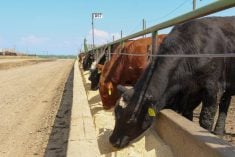During the first half of October, Alberta packers were buying fed cattle on a dressed basis in the range of $300-$305 delivered. Using a 60 per cent grading, this would equate to $180-$183/cwt on a live basis.
For March and April delivery, Alberta packers have been forward contracting in the range of $345-$350 cwt on a dressed basis or $207-$210/cwt on a live scale. The Alberta fed market for nearby and deferred delivery positions was been relatively flat over the six weeks until mid-October.
While the fed cattle market has held value, the feeder market has come under pressure. Lethbridge-area feedlots were buying feed barley in the range of $425-$445/tonne. The barley market has rallied nearly $80/tonne from the harvest lows during August. This has been the main factor limiting the upside for the feeder market.
Read Also

Harvest wraps up and fall work begins
At the Eppich famly ranch in western Saskatchewan, the fall harvest was successful with few breakdowns, cows and calves have been sorted and a new tractor has arrived
Yearling prices for 900-pound steers off grass in central Alberta were quoted in the range of $228-$232 in October. Calves weighing 550 to 750 pounds were down approximately $10-15/cwt from 30 days earlier. Steers weighing 550 to 600 pounds were quoted in the range $255-$265/cwt in central and southern Alberta. Larger supplies are coming on the market at this time of year and strength in the barley market appears to be pressuring the lighter weight categories.
U.S. cattle on feed inventories in 1,000-head plus feedlots were 11.279 million head, up 45,000 head from Sept. 1, 2021. U.S. feedlot placements during August were 2.112 million head, up 9,000 head from 12 months earlier. Despite the year-over-year decrease in the U.S. calf crop, U.S. cattle on feed numbers and feeder cattle placements have been coming in larger than expected. This is largely due to the drought in the U.S. Southern Plains (New Mexico, Texas, Kansas and Oklahoma) and high corn prices.
[RELATED] Feed weekly outlook: Looming corn imports to keep lid on Prairie barley
As of mid-October, feedlot operators in Texas and Kansas were buying corn at an equivalent price of US$327/tonne or C$450/tonne. In Oklahoma City, 500-550-pound steers were averaging US$197/cwt or C$269/cwt; 600-650-pound steers were averaging US$190/cwt or C$260/cwt.
In the last three USDA cattle on feed reports, U.S. feedlot placements in the under 700 pounds have been above year-ago levels while placements of feeders weighing 700 pounds or more have been marginally lower than year-ago levels.
U.S. drought has an impact
The drought in the Southern Plains has altered the feeder market outlook. First, earlier in summer I expected the feeder market to trade high enough to encourage heifer retention. Comments from south of the border reflect that there is no heifer retention for herd expansion. Feeder cattle prices in the U.S. are not high enough to encourage heifer retention. Secondly, feeder cattle on small-grain pasture will be down from a year ago. On Jan. 1, 2022, there were 1.7 million head of cattle grazing on small-grain pasture in Texas, Oklahoma and Kansas. The Jan. 1, 2023 number could be down as much as 20 to 30 per cent. This will cause an additional 300,000 head of feeders to move into feedlots rather than be sold in March of 2023. Finally, the U.S. cow slaughter has been exceeding expectations. Recent data shows there is no slowdown.

This situation will cause U.S. beef production during the fourth quarter of 2022 and first quarter of 2023 to come in higher than earlier projections. The USDA has been raising its beef production forecasts on the previous WASDE (World Agriculture Supply and Demand Estimates) reports. How is this going to influence the Canadian cow-calf producer?
Current Canadian prices for feeder cattle are high enough to encourage heifer retention. Except for western Saskatchewan, feed and forage supplies are sufficient for the cow-calf producer. Barley prices are trending upward but this is more of a problem for the finishing feedlot.
In Western Canada, feeder cattle outside finishing feedlots as of July 1 were down 274,000 head compared to July 1, 2021. Feeder cattle exports to the U.S. are running sharply higher than a year ago, while imports of U.S. feeder cattle (mostly Holstein feeders) are down sharply. Given the current prices for feeder cattle, we could see another 50,000 to 75,000 head of heifers held back for heifer retention in Western Canada. Cow-calf prices and bred heifers were very reasonable throughout the summer and fall.
Heifer retention in the U.S. has been delayed by one year due to the significant drought in the U.S. Southern Plains. I’m expecting a sharp year-over-year decline in the U.S. cow slaughter throughout 2023. During the spring of 2023, the U.S. feeder market will function to encourage expansion. Seasonal rains occur in the Southern Plains during April. This could cause western Canadian yearlings to trade at $10-$15/cwt above current levels during April and May of 2023. During the fall of 2023, we could see calves in central Alberta trade $25 as much as $40/cwt higher than in 2022. There is a bright outlook for the feeder market for the next year.
















